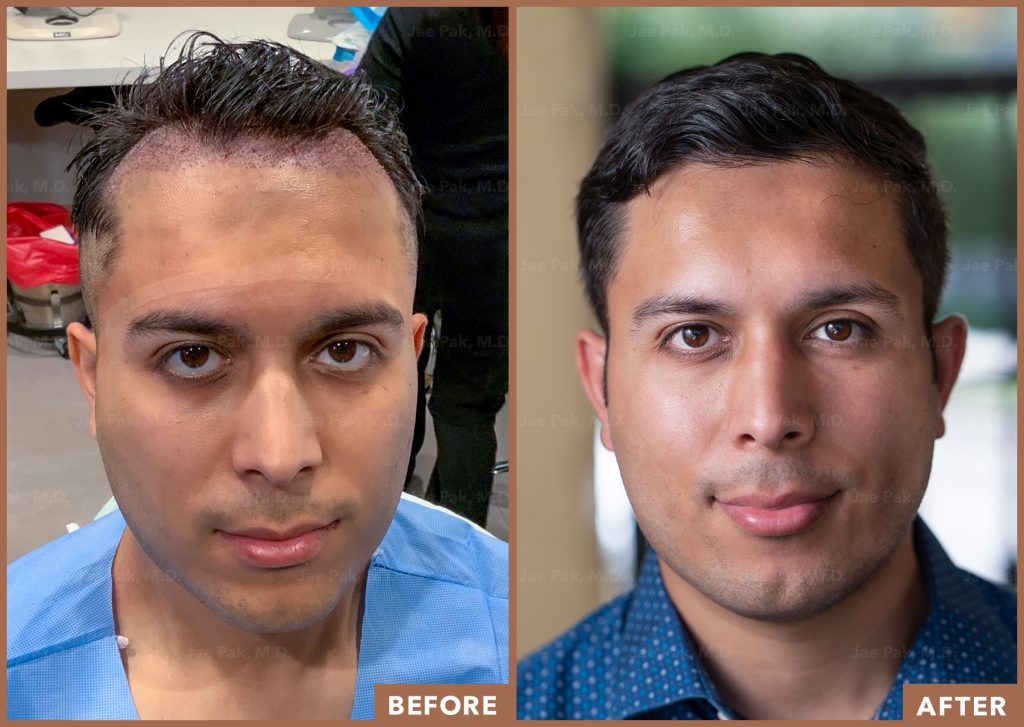
Stock Photo by SHTTEFAN on Unsplash
When you picture the perfect hairline, there’s one factor that always applies in your mind’s eye: symmetry. The most enviable hairlines always seem to be perfectly even, as if a mirror image is split right down the middle and reflected to either side.
That’s why it can be disconcerting for men and women to notice asymmetry on their hairlines as they age, even if the pattern is barely noticeable without real scrutiny.
An uneven hairline can be cause for concern no matter who you are, and even if the rest of your hair appears to be healthy and strong, you might still want to address the issue of asymmetry.
Let’s discuss all the possible causes for an uneven hairline, then explore the many ways we can address – and even fix – an uneven hairline with modern medicine, new therapeutics, and cutting-edge procedures from the world of hair restoration.
Everyone who thinks of an uneven hairline conjures up a different mental image.
Here’s an overview of what we really mean when we talk about uneven hairlines, the various patterns we tend to see, and whether it’s a problem that should be taken seriously.
Since the term “uneven hairline” is so broad, there is no singular definition used in the world of cosmetics and hair restoration.
That’s why it’s more useful to look at this phenomenon as any type of hairline with noticeable asymmetry, meaning one side is substantively different from the other when split down the middle of the frontal scalp.
Uneven hairlines also may be defined differently depending on factors including an individual’s age, sex, ethnicity, hair type, skull shape, and more.
While a pattern like a widow’s peak or subtle M-shaped hairline may be seen as uneven because it is simply not linear and flat, this is often not classified as an uneven hairline.
Keep in mind that a perfectly even, straight hairline is exceedingly rare, and some people use this as a catch-all term to encompass any hairline that doesn’t meet this unrealistic ideal.
When it comes to hair restoration, we typically use the term to identify a hairline with more severe asymmetry and requires a strategy to improve or correct.
Uneven hairlines come in many forms and can look drastically different based on the factors we have described.
An uneven hairline will often be made obvious with significantly more hair – and hair of higher quality – on one side of the head than the other.
A hairline may also feature patchiness along the front of the head or the temples, which tend to be associated with androgenetic alopecia in men.
For women, an uneven hairline may be signified by a choppy, zig-zag pattern that may look like a series of connected W’s in a row. Some women have a substantially higher hairline on one side of the head than the other, while the disparity is less noticeable for others.
In many cases, an uneven hairline will look perfectly smooth and linear on one side but jagged or disrupted on the other. Once again, all cases are different, and custom solutions are needed to address them for patients who wish to make changes or improvements.
Some degree of facial asymmetry is expected in all humans, even the ones we consider to be most attractive. Hairlines are simply a part of this equation, and in many cases, they are nothing to be concerned about.
In the context of hair restoration, patients with uneven hairlines seek assistance simply because they are unhappy with the structure and symmetry of their hair, which are perfectly viable reasons to make a change.
Many hairlines are just naturally asymmetrical, and some minor fixes can go a long way to make them more even and structured in a way that complements one’s facial features more naturally.
However, an uneven hairline isn’t always a diagnosis or a mild observation.
It can be a sign of things to come for an individual as their hair matures and goes through the process of miniaturization, thinning, or pattern balding, as illustrated in the Norwood and Ludwig scale charts.
For patients who notice the rapid progression of an uneven hairline for a few years or even faster, a hair restoration specialist can work their magic to properly diagnose the issue and map out a strategy to slow or reverse course.
For most folks with uneven hairlines, it’s simply a matter of genetics and the cards they were dealt. But there are other unnatural reasons why an uneven hairline may develop as someone ages.
Let’s look at the common reasons for uneven hairlines before we jump into solutions.
How we treat our hair daily is a huge factor in the health and life cycle of our hair. Prolonged mistreatment can result in uneven hairlines if we’re not careful.
The overuse of hair products or exposure to toxic environmental factors are becoming a more common cause for uneven hairline and general hair health issues.
These can include hair dyes and synthetic styling products to high-heat curling and flattening irons. Depending on how hair is styled and what’s required to achieve that look, damage can be done over time through repetition and lack of care to offset the effects.
Traction alopecia is also a frequent cause of uneven hairline in patients who wear their hair “up” and cause strain on the hairline with styles like top-buns, ponytails, and other configurations that slowly pull the hair in an unnatural direction for hours on end.
While most androgenetic alopecia shows a predictable progression with tools like the Norwood scale, it can also lead to uneven hairlines.
Since DHT appears to be the main driver in this type of hair loss, research suggests that uneven concentrations of this compound in the scalp could lead to uneven hairlines in men. For women, uneven thinning is more likely to occur along the part of the hair, which may be asymmetrical in the first place.
In other cases, androgenetic alopecia will start with an M-shaped hairline for men, which may look symmetrical but isn’t desirable. For those who notice asymmetry in the early stages of thinning, this is typically a good time to take proactive measures.
The majority of uneven hairlines are genetic or the result of environmental and self-inflicted factors.
Still, there are other reasons why an uneven hairline may form, including autoimmune disorders, hormonal problems, traumatic events, or negative reactions to unrelated medications or procedures.
As is the case with many causes of this kind, uneven hairlines are difficult to fix with the typical lineup of hair restoration treatments.
That’s why hair restoration professionals look at the full range of medical and physiological reasons for hairline trends and address the problems holistically before leaping to conclusions.
Uneven hairlines can indeed be fixed, and there are multiple ways to approach it.
Here are the three main treatments used to bring clients closer to hairline symmetry, ranging from low to high in terms of cost and effort.
The fastest and easiest way to navigate an uneven hairline is to restyle one’s hair in a way that draws the eye away from the point of concern or conceals it all together with hair from the upper region of the scalp.
Men and women can successfully employ styles such as bangs, sweeps, tousled hair, and other tactics to make an uneven hairline more naturally attractive or completely covered over. Another advantage here is limiting stress caused by traction alopecia.
Obviously, this becomes an issue when an individual doesn’t have the necessary volume of hair to achieve these styles in a way that looks natural or complements their features.
In this case, some may choose to use temporary filler or concealer products like keratin fibers to add volume and texture to the hairline and create a more symmetrical look.
While quick, the downsides of these strategies include limited styles and impermanence.
Even with an uneven hairline, improving one’s lifestyle is always part of a complete hair restoration program. Strengthening all pillars of health and reducing reliance on synthetic products can help hairlines recover in many cases.
Organic and natural hair supplements should also be considered when addressing this issue early on. Essential oils, collagen, biotin, and others top the list.
Finally, men will want to consider the proven combination of topical Minoxidil and one-a-day oral Finasteride to slow the progression of an uneven hairline due to androgenetic alopecia.
More patients are looking to advanced therapies and surgical solutions to fix uneven hairlines with more permanent results.
Microchanneling/Microneedling has shown promise as a therapy to stimulate growth on the hairline and low-light laser therapies and platelet-rich plasma injections.
On the surgical front, traditional follicular unit transplant, or strip surgery, is the most popular method to restore real, natural hair to the target area and restore a more aesthetic and even hairline. Follicular unit excision (FUE) is also rising in popularity for smaller procedures.

Since these treatments and surgeries tend to be more costly and time-consuming, we recommend that clients book consultations and go through a full, in-person analysis with a hair restoration expert to plot out a course of action.
Uneven hairlines can look natural and charming or be a source of distress for individuals concerned about the progression of hair loss at any age.
Connect with our team at Jae Pak, MD, and we’ll get you on the right track with a personalized solution to fix your uneven hairline for good.
Sources:
Asymmetry of Receding Hairline | NIH
Speak with Jae Pak, M.D. today!
Request a Consultation